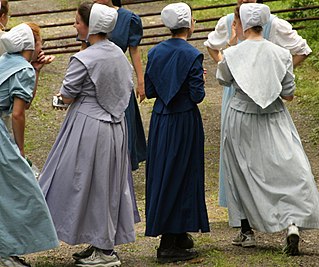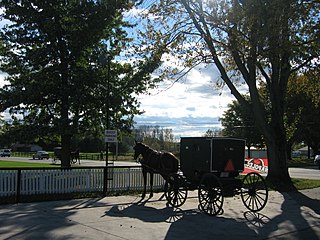
Mennonites are a group of Anabaptist Christian communities tracing their roots to the epoch of the Reformation. The name Mennonites is derived from the excommunicated Roman-Catholic chaplain Menno Simons (1496–1561) from Friesland, part of the Holy Roman Empire, present day Netherlands. Menno Simons became a prominent leader within the wider Anabaptist movement and was a contemporary of Martin Luther (1483–1546) and Philip Melanchthon (1497-1560). Through his writings about the Reformation Simons articulated and formalized the teachings of earlier Swiss Anabaptist founders as well as early teachings of the Mennonites founded on the belief in both the mission and ministry of Jesus. Formal Mennonite beliefs were codified in the Dordrecht Confession of Faith (1632), which affirmed "the baptism of believers only, the washing of the feet as a symbol of servanthood, church discipline, the shunning of the excommunicated, the non-swearing of oaths, marriage within the same church", strict pacifistic physical nonresistance, anti-Catholicism and in general, more emphasis on "true Christianity" involving "being Christian and obeying Christ" as they interpret it from the Holy Bible.

The Old Order River Brethren are a River Brethren denomination of Anabaptist Christianity with roots in the Radical Pietist movement. As their name indicates, they are Old Order Anabaptists.

The Mennonite Church USA is an Anabaptist Christian denomination in the United States. Although the organization is a recent 2002 merger of the Mennonite Church and the General Conference Mennonite Church, the body has roots in the Radical Reformation of the 16th century.
Old Order Mennonites form a branch of the Mennonite tradition. Old Order are those Mennonite groups of Swiss German and south German heritage who practice a lifestyle without some elements of modern technology, still drive a horse and buggy rather than cars, wear very conservative and modest dress, and have retained the old forms of worship, baptism and communion.
Amish Mennonites came into existence through reform movements among North American Amish mainly between 1862 and 1878. These Amish moved away from the old Amish traditions and drew near to the Mennonites, becoming Mennonites of Amish origin. Over the decades, most Amish Mennonites groups removed the word "Amish" from the name of their congregations or merged with Mennonite groups.
The Stauffer Mennonites, or "Pikers", are a group of Old Order Mennonites. They are also called "Team Mennonites", because they use horse drawn transportation. In 2015 the Stauffer Mennonites had 1,792 adult members.

Franconia Mennonite Conference was a conference of Mennonite Church USA based in Lansdale, Pennsylvania, with 45 congregations in Pennsylvania, New Jersey, Vermont, New York and California and 19 conference related ministries. In February 2020, Franconia Mennonite Conference merged with Eastern District Conference to become Mosaic Mennonite Conference. It is a member of Mennonite World Conference.
The Beachy Amish Mennonites, also known as the Beachy Amish or Beachy Mennonites, are an Anabaptist group of churches in the Conservative Mennonite tradition that have Amish roots. Although they have retained the name "Amish" they are quite different from the Old Order Amish: they do not use horse and buggy for transportation, with a few exceptions they do not speak Pennsylvania Dutch anymore, nor do they have restrictions on technology except for radio and television. In the years 1946 to 1977 a majority of the Beachy Amish incorporated certain elements of revivalist practice, such as the preaching of the New Birth. The traditionalists who wanted to preserve the old Beachy Amish ways then withdrew and formed their own congregations. Today they are known as Midwest Beachy Amish Mennonites or Old Beachy Amish.

The Groffdale Conference Mennonite Church, also called Wenger Mennonites, is the largest Old Order Mennonite group to use horse-drawn carriages for transportation. Along with the automobile, they reject many modern conveniences, while allowing electricity in their homes and steel-wheeled tractors to till the fields. Initially concentrated in eastern Lancaster County, Pennsylvania, their numbers had grown to 22,305 people resided in eight other states as of 2015. They share the pulpit with the Ontario Mennonite Conference but have some differences in Ordnung.
Funkites were a group of Mennonite (Anabaptist) followers that splintered from mainstream Mennonites as the result of a schism caused by Bishop Christian Funk.
Conservative Mennonites include numerous Conservative Anabaptist groups that identify with the theologically conservative element among Mennonite Anabaptist Christian fellowships, but who are not Old Order groups or mainline denominations.

The Weaverland Conference, also called Horning Church or Black-bumper Mennonites, is a Christian denomination of Old Order Mennonites who use cars.
Joseph Wenger (1868–1956) was an Old Order Mennonite preacher, who, in the 1927 schism of the Weaverland Old Order Mennonite Conference was ordained bishop by bishops in Indiana, Michigan, and Virginia, and made head of a new branch broken from the Weaverland Conference. The branch, which split from Weaverland over the issue of adopting the automobile, became formally known as the Groffdale Conference Mennonite Church, the congregation where Wenger preached, but is also informally known as the Wenger Church.
The Mennonite Church USA Archives was founded in 2001 under the denominational merger of the (old) Mennonite Church and the General Conference Mennonite Church. Prior to 2001, the two largest Mennonite denominations maintained separate archives: the Archives of the Mennonite Church, located on the Goshen College campus, housed materials pertaining to the (old) Mennonite Church, while the Mennonite Library and Archives on the Bethel College campus held the records of the General Conference Mennonite Church.
The Markham-Waterloo Mennonite Conference (MWMC) is a Canadian, progressive Old Order Mennonite church established in 1939 in Ontario, Canada. It has its roots in the Old Order Mennonite Conference in Markham, Ontario, and in what is now called the Regional Municipality of Waterloo. The Conference adheres to the 1632 Dordrecht Confession of Faith. The Markham-Waterloo Mennonite Conference is in fellowship with two similar car-driving Old Order Mennonite churches: the Weaverland Mennonite Conference and the Ohio-Indiana Mennonite Conference.
The Women's Missionary and Service Commission, previously known as the Women's Missionary and Service Auxiliary and abbreviated WMSC or WMSA, was a women's organization of the "old" Mennonite Church that originated out of the Mennonite Sewing Circle movement. Named the WMSC in 1971, there were many precursor organizations and it has since evolved into Mennonite Women USA, an organization with a much wider scope.
Heinrich Funck was a mill operator, religious author and a Mennonite bishop in America.
The Virginia Old Order Mennonite Conference, also called Cline Mennonites or Cline-Showalter group, is an Old Order Mennonite group to use horse-drawn carriages for transportation. It separated from the Virginia Mennonite Conference in 1901. The members of the group speak English only, unlike almost all other horse and buggy Old Order Mennonite groups, who speak Pennsylvania German as their first language. In recent years the group sometimes uses the name "Riverdale Old Order Mennonite Church".
The John Dan Wenger Mennonites are an Anabaptist Christian denomination that belongs to the Old Order Mennonites. They use horse and buggy transportation and are mainly located in Virginia. Under the leadership of Bishop John Dan Wenger, they separated from the Virginia Old Order Mennonite Conference in either 1952 or 1953.

The Byler Amish, also called Alt Gemee, are a small conservative subgroup of the Amish. They are known for the yellow color of their buggies, which earned them the nickname "yellow-toppers" and for wearing only one suspender. They are the oldest Old Order Amish affiliation that separated for doctrinal and not for geographical reasons.






